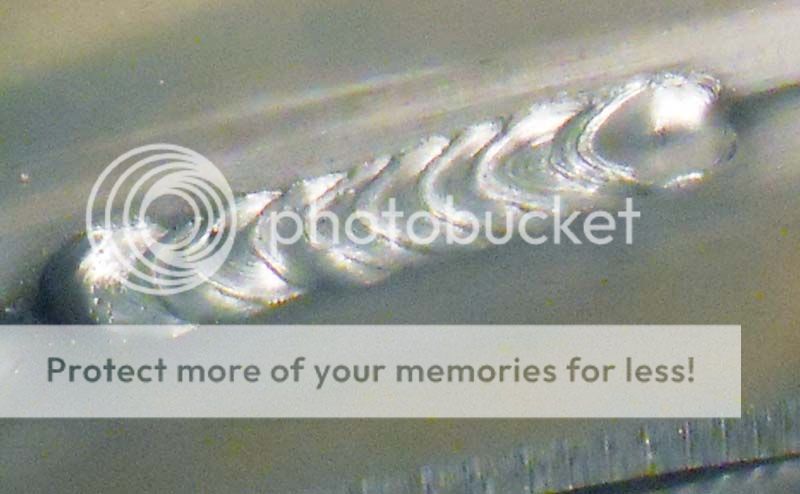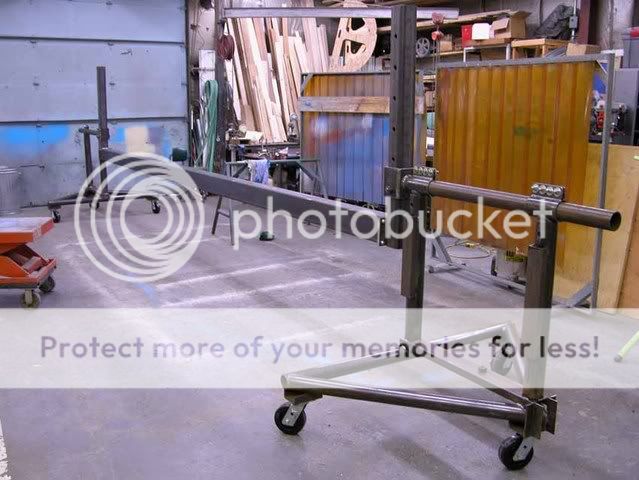Armor, I forgot and didn't pay attention to the fact you'd said it was a bulkhead so it needed to be sealed.
I'd weld the seal- not calk. I only use calk as bedding or insulation and there sparingly if possible. The weld I'd do is down (gun to the right), starting a few inched up the vertical, moving down and then pulling the gun to the left leading the weld to the left so I could see as I'm a right handed torch welder. I'd be working from he left side of the gun for visibility and reach. As you say very tight place to weld, so I use the rotisserie or plan to do welds like these earlier in the sequence of weldout.
I would never use sealant of any kind (that I've seen) in any bulkhead seal in a welded boat. I'd weld every seam, but as you've mentioned- since its mainly a sealant, why
not weld down hand even if you think that is a substandard weld? Its one world of improvement over glue.
The down hand aluminum break bend is not the same as steel. Besides steel as a model for aluminum is not valid. And last; how many boats hulls has the weld teacher built? If its more than a couple dozen I'm willing to listen to his ideas, less than that and I'll just go with my own experience.
I've been told by lots of folks that one or another 'method' I use
won't work but they all still floating. Dave Gerr has mentioned in print and other forums that aluminum can't be welded below 1/8" in thickness, but I have welded less than half that on a regular basis for decades, so; while I'm willing to respect others' opinions
for their own experiences- I have experiences that don't always match so I'll rely on mine over others, and leave them to stay with their ideas over mine.
You can, anytime you want, set up some coupons and give down hand a try, single side, double side, beveled and butt T edges; they'd all give good information in my experience. That is why I always bevel bulkhead welds, both to the hull bottom and sides, and I also bevel lots of other places; but get told
"you don't need too".
One other item about bulkhead seams done down hand. What weld failure test is appropriate? I mean we usually use the back bend where the T coupon is pulled over the face of the weld to see when it fails- right. But what does that imply for a boat's catastrophic failure event? It implies the bulkhead's weld has been pulled @ 90 deg over the bottom or topsides -along the length the keel! In other words an explosion of such power the entire bulkhead was 'back bent' over the weld.
I think a more realistic test is to cut a section of the T fillet coupons and crush then in a press. The T of the fillet up, the flat of the T on the press and then crush the two pieces and the weld connecting them. Even reversing the test crush orientation is good information. This simulates a T-bone boat collision of a huge cargo ship driving into the side of your boat (

) or.... in the case of the bottom it simulates the boat being dropped by a wave onto a piling or other sharp object where the forces can be concentrated.

Now, how did the weld fair? In my experience of repairing and surveying the damage to many of my boats that were landed on rock beaches in a dry breaking surf, carrying huge loads; the welds held the two pieces of the hull together and the entire area dented or bent inward but the welds were in tact.
I blew up a tank one time that taught me a lot of lessons. The tank's wall was 1/8" and the baffles were welded down hill inside the tank before the top was welded on.

this scan of a Polaroid of the trophy is not all that clear but what this 'weld test' showed was the entire area around each of the baffle weld stitches done downhand on the 1/8" plate tore the plate away. The welds held the parent metal of the baffle and the sides together but the tear of the sides was at the HAZ around each weld. I implied then and do now that this meant the weld 'beat the metal' in a somewhat worst case test.
Not all weld tests or techniques are useful for hull work simulations or planning. Down hill welding MIG aluminum is a completely legitimate weld where you're weld thin sheet (<0.187"- 3/16") to the same or thicker materials. These welds can be done with 0.045" wire or 0.035" wire but the heavier wire allows faster travel and higher wattage giving better wetting at the higher speeds.
99% of Americas high pressure pipelines are welded downhand, root, hot and even filler passes all downhand with stick!
AWS barely cover the smaller boats with 1/8" structural elements and are written to protect insurance and finance companies- which is fine those folks do need protection from welders without adequate skills who may produce substandard work. They are very conservative as a result, and I don't find them addressing thin plate construction.
What I'm pointing out is that the average purely welded aluminum boat is overbuilt to a fact of from 2 to 20 in most cases. In the case of not doing a down hand weld because they don't in ship yards- its not an apples-to-apples comparison. At least I don't see the direct correlation.
When you try some thin material down hand test weld coupons and test them you'll see that continuous welding does have a high degree of structural integrity even if applied in the downhand orientation. If you can already do these welds - then all you need are some coupon tests to convince yourself you can rely on them?
Cheers,
Kevin Morin
Kenai, AK











